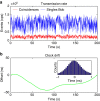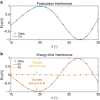Distribution of high-dimensional entanglement via an intra-city free-space link
- PMID: 28737168
- PMCID: PMC5527279
- DOI: 10.1038/ncomms15971
Distribution of high-dimensional entanglement via an intra-city free-space link
Abstract
Quantum entanglement is a fundamental resource in quantum information processing and its distribution between distant parties is a key challenge in quantum communications. Increasing the dimensionality of entanglement has been shown to improve robustness and channel capacities in secure quantum communications. Here we report on the distribution of genuine high-dimensional entanglement via a 1.2-km-long free-space link across Vienna. We exploit hyperentanglement, that is, simultaneous entanglement in polarization and energy-time bases, to encode quantum information, and observe high-visibility interference for successive correlation measurements in each degree of freedom. These visibilities impose lower bounds on entanglement in each subspace individually and certify four-dimensional entanglement for the hyperentangled system. The high-fidelity transmission of high-dimensional entanglement under real-world atmospheric link conditions represents an important step towards long-distance quantum communications with more complex quantum systems and the implementation of advanced quantum experiments with satellite links.
Conflict of interest statement
The authors declare no competing financial interests.
Figures



 in the polarization basis (blue line) and
in the polarization basis (blue line) and  in the energy–time basis (orange line). Almost no interference was observed when the energy–time to polarization transfer set-up was introduced in Alice’s detection module only (yellow line,
in the energy–time basis (orange line). Almost no interference was observed when the energy–time to polarization transfer set-up was introduced in Alice’s detection module only (yellow line,  ).
).
Similar articles
-
Four-dimensional entanglement distribution over 100 km.Sci Rep. 2018 Jan 16;8(1):817. doi: 10.1038/s41598-017-19078-z. Sci Rep. 2018. PMID: 29339764 Free PMC article.
-
Long-Distance Entanglement Purification for Quantum Communication.Phys Rev Lett. 2021 Jan 8;126(1):010503. doi: 10.1103/PhysRevLett.126.010503. Phys Rev Lett. 2021. PMID: 33480791
-
Quantum teleportation and entanglement distribution over 100-kilometre free-space channels.Nature. 2012 Aug 9;488(7410):185-8. doi: 10.1038/nature11332. Nature. 2012. PMID: 22874963
-
Quantum hyperentanglement and its applications in quantum information processing.Sci Bull (Beijing). 2017 Jan 15;62(1):46-68. doi: 10.1016/j.scib.2016.11.007. Epub 2016 Dec 2. Sci Bull (Beijing). 2017. PMID: 36718070 Review.
-
High-dimensional entanglement between distant atomic-ensemble memories.Light Sci Appl. 2016 Oct 21;5(10):e16157. doi: 10.1038/lsa.2016.157. eCollection 2016 Oct. Light Sci Appl. 2016. PMID: 30167124 Free PMC article.
Cited by
-
Optical scheme for generating hyperentanglement having photonic qubit and time-bin via quantum dot and cross-Kerr nonlinearity.Sci Rep. 2018 Feb 7;8(1):2566. doi: 10.1038/s41598-018-19970-2. Sci Rep. 2018. PMID: 29416070 Free PMC article.
-
Design of Metasurface with Nanoslits on Elliptical Curves for Generation of Dual-Channel Vector Beams.Nanomaterials (Basel). 2021 Nov 11;11(11):3024. doi: 10.3390/nano11113024. Nanomaterials (Basel). 2021. PMID: 34835788 Free PMC article.
-
Preparation of quantum information encoded on three-photon decoherence-free states via cross-Kerr nonlinearities.Sci Rep. 2018 Sep 14;8(1):13843. doi: 10.1038/s41598-018-32137-3. Sci Rep. 2018. PMID: 30218095 Free PMC article.
-
Four-dimensional entanglement distribution over 100 km.Sci Rep. 2018 Jan 16;8(1):817. doi: 10.1038/s41598-017-19078-z. Sci Rep. 2018. PMID: 29339764 Free PMC article.
-
Creating heralded hyper-entangled photons using Rydberg atoms.Light Sci Appl. 2021 May 12;10(1):100. doi: 10.1038/s41377-021-00537-2. Light Sci Appl. 2021. PMID: 33976109 Free PMC article.
References
-
- Ursin R. et al.. Entanglement-based quantum communication over 144 km. Nat. Phys. 3, 481–486 (2007).
-
- Fedrizzi A. et al.. High-fidelity transmission of entanglement over a high-loss free-space channel. Nat. Phys. 5, 389–392 (2009).
-
- Jin X.-M. et al.. Experimental free-space quantum teleportation. Nat. Photon. 4, 376–381 (2010).
-
- Scheidl T., Wille E. & Ursin R. Quantum optics experiments using the international space station: a proposal. N. J. Phys. 15, 043008 (2013).
-
- Vallone G., Marangon D. G., Tomasin M. & Villoresi P. Quantum randomness certified by the uncertainty principle. Phys. Rev. A 90, 052327 (2014).
Publication types
Grants and funding
LinkOut - more resources
Full Text Sources
Other Literature Sources

